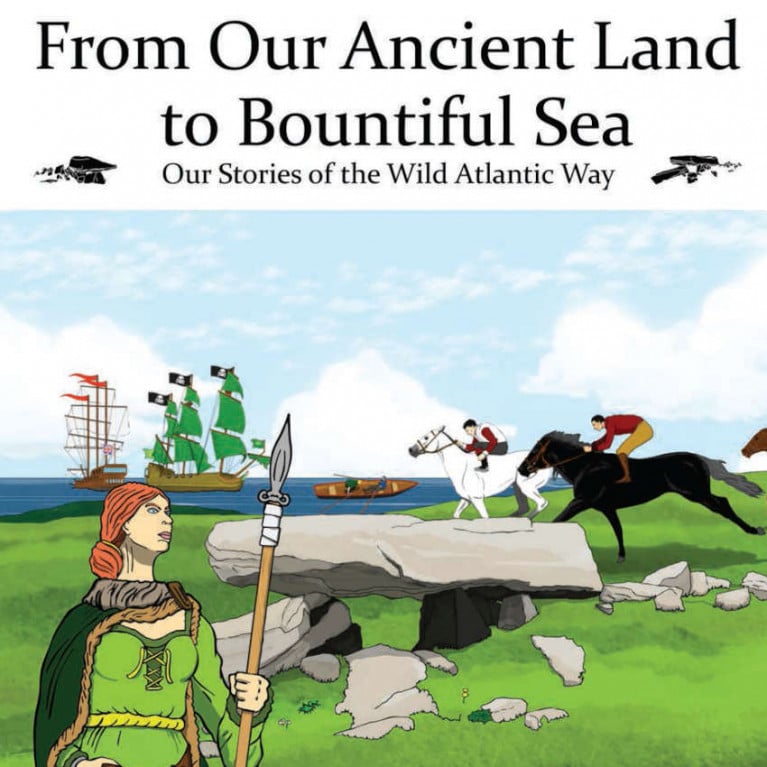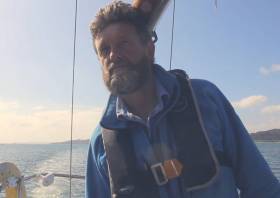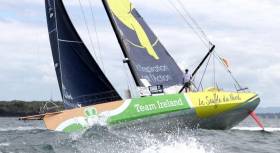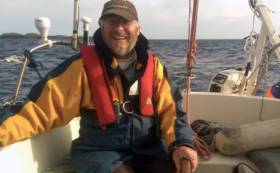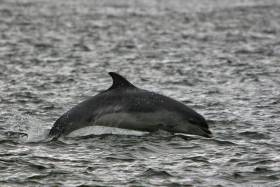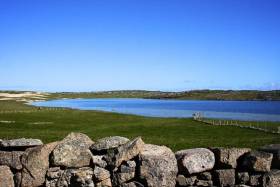Displaying items by tag: Books
‘It Was Horrible to Be Out There’: Galway Cousins Share the Story of Their Harrowing Paddle Board Ordeal
In the first of three extracts from Lorna Siggins’ new book, Search and Rescue, the journalist and regular Afloat.ie contributor recounts the harrowing ordeal of two Galway cousins, Sara Feeney and Ellen Glynn, who were reported missing on 12 August 2020 after they went paddle boarding off Furbo beach in Co Galway…
Air temperatures of around 18 degrees had fallen to 15 degrees during the night. Even though the sea was warm – at around 18 degrees – the estimates for survival at sea in normal clothing would be around twenty hours. The two women weren’t aware of this, but they were well aware of their vulnerability in bikinis and lifejackets.
Ellen was worried about her own lack of tolerance for cold, but the water had been warm that evening. They kept checking the shore lights, paddling and waiting, and still feeling bad about ‘all the hassle we were causing’.
Neither wanted to say what they really thought. Ellen, who was a little stressed, felt an uncontrollable urge to burst into song. She belted out the lyrics of Taylor Swift’s ‘Exile’. ‘At first I’d say Sara thought I was a bit insane,’ she said later. ‘But she just sorta started singing along … it was a distraction … that was just before the first boat came.’
Sara recalled: ‘We definitely knew there was activity and people looking for us. At one point, a boat lit a flare close to us to signal to the helicopter … We thought they would pick up the reflective strips on the boards, or on our buoyancy aids. … Not long after that, we saw the first helicopter. It felt like they were very close … You get that initial sense of relief and then … we would scream and roar and no one could hear.’
They continued to paddle, all the while straining to identify the lights on the shore. In the downdraught caused by the helicopters and the wash from searching vessels, they struggled at times to stay on the boards. Ellen had fallen off once already, earlier in the night. Instinctively sensing they needed to keep their spirits up, they chatted about what they would most like to do when they arrived back. Ellen said she was really looking forward to a hot shower and getting into comfy pyjamas. They talked about how lucky they were to have their lifejackets on, how people were looking for them, how they were going to be found and how everything would be fine.
 Father and son Patrick and Morgan Oliver, who rescued Ellen Glynn and Sara Feeney after they were found off Inis Oírr in August 2020. With the Olivers are Galway RNLI lifeboat crew members (from left to right) Olivia Byrne, Sean King, Ian O’Gorman, Cathal Byrne, Stefanie Carr, Declan Killilea and Lisa McDonagh who were out all night on the search | Credit: Joe O’Shaughnessy
Father and son Patrick and Morgan Oliver, who rescued Ellen Glynn and Sara Feeney after they were found off Inis Oírr in August 2020. With the Olivers are Galway RNLI lifeboat crew members (from left to right) Olivia Byrne, Sean King, Ian O’Gorman, Cathal Byrne, Stefanie Carr, Declan Killilea and Lisa McDonagh who were out all night on the search | Credit: Joe O’Shaughnessy
Ellen remembered at one point thinking about how cold it must be for those sleeping out every night with no homes to go to. She only had to be ‘there for one night’, she told herself. The line from ‘Exile’ about seeing ‘this film before’ and not liking the ending kept looping around in her head, and she sent silent mind messages to her mum, reassuring her that she was okay.
While on the water, they witnessed the meteor shower and marvelled at bioluminescent light for a time as the seas were lit up by the chemical reactions of millions of tiny marine organisms.
‘So I remember, when we saw the shooting stars, I’d always wanted to see them, so I thought that was really cool, and then the plankton in the water,’ Ellen said. ‘They’d been in the water a year before that, and I didn’t get to see them, so I was kind of thinking in my head, “Am I getting to see all this stuff now because I’m going to die?”’
Sara said: ‘With the meteor shower, between the two of us there was some amount of wishes made. To be honest, I’d sacrifice a meteor shower and bioluminescence just to get home safe...We were singing, talking, anything we could to keep our moods up. If fear was seeping in, one of us would reassure the other...
‘It was horrible to be out there and realise everyone would be worried sick, and it felt really awful that everyone spent so many hours looking for us. I think if we had panicked at all, things could have been very different. I know if Ellen had panicked, I would have found it very difficult.’
The weather deteriorated and the rain was so heavy that it hurt. They had stopped seeing any lights of vessels, any search activity now. Their last sight of a helicopter was just before the lightning storm at around 4.20 a.m. When the aircraft flew off, they knew they would have to stick it out to first light.
At that point, Sara had a clear memory of being enveloped in a fear that she could not articulate, knowing the impact any mention of this might have on her cousin: ‘The chances aren’t too good for you if the helicopter couldn’t be out in those conditions … you know … because the size of the helicopter compared to us and all we have is the boards … You see the helicopter going in, because of the stormy weather, and that didn’t bode well for us. We didn’t even verbalise what might happen, or what we might both be thinking. Ellen probably had total understanding of what was going on, but neither of us really communicated that to each other … we didn’t really say that out loud at the time. If we had started talking like that, it was just another level of hopelessness we didn’t need.’
 The Galway RNLI inshore lifeboat returning after the cousins were found on their paddle boards off the Aran island of Inis Oírr | Credit: Joe O’Shaughnessy
The Galway RNLI inshore lifeboat returning after the cousins were found on their paddle boards off the Aran island of Inis Oírr | Credit: Joe O’Shaughnessy
They lay down on the boards, trying to stay as stable as possible in waves of up to 2 metres in height, hoping they could just wait the night out. Ellen thought they were being carried towards Kinvara, though she wasn’t sure.
Sara had a sense her cousin might be falling asleep, so she played word games with her to keep her alert and urged her to kick her legs every so often to keep warm.
***
The Galway RNLI crew came alongside Barna pier during the night for extra fuel and a crew change. By 5 a.m. local fishing vessels were out.
Back on Cappagh road, the light came on in Mary Feeney’s bedroom, waking her and her husband, Tommy. Her eldest, Karen, and youngest, Donal, were at the foot of her bed. They explained that they had some news. Her two granddaughters were missing at sea. As she tried to make sense of the information, Mary remembered giving Karen and Donal a couple of lamps to take back out with them.
Back in Galway lifeboat station, co-ordinator Mike Swan arrived around 6 a.m. to check in with his colleague Barry Heskin, who had been on duty throughout the night. The situation was not looking good, given the night’s bad weather on the bay. Some of the lifeboat crew who had been out in the early hours had crashed in chairs or were lying on the pool table to grab some sleep. Breakfast rolls had sustained them during a long night at sea and Swan had organised a box of the same for colleagues on the RNLI Aran lifeboat.
Sailor and yacht chandler Pierce Purcell received an early morning call and set his energies to putting the word out among the sailing clubs, while the family put out posts on social media, appealing for help. Several fishing vessels contacted John O’Donnell on the Aran lifeboat to get advice on where to search. Ferries serving the Aran Islands based in Doolin and in Ros-a-Mhíl also declared they would assist. Several private pilots – John Kiely and Patrick Curran – joined in with a light plane and helicopter respectively, as did Aer Arann on its routine flights between Indreabhán and the islands.
 An Irish Coast Guard S-92 landing at University Hospital Galway with cousins Ellen Glynn and Sara Feeney on board, after they were flown from Inis Oírr | Credit: Joe O’Shaughnessy
An Irish Coast Guard S-92 landing at University Hospital Galway with cousins Ellen Glynn and Sara Feeney on board, after they were flown from Inis Oírr | Credit: Joe O’Shaughnessy
‘We took one of our ferries out from Doolin at 9 a.m. – the Jack B – with Captain James Fennell, my nephew Martin Garrihy and myself on board. Island Ferries was also searching in between sailings out of Ros-a-Mhíl, and Bill O’Brien of Doolin Ferries,’ Donie Garrihy said.
‘We scoured around Inis Oírr and were then told to search between Inis Oírr and Inis Meáin as far down as the lighthouse, and then got a call to double back up from Inis Oírr towards Spiddal.’
The Oranmore-Maree Coastal Search Unit became involved, as did the Marine Institute. The institute had expertise in modelling, combining tide, currents and weather to predict drift patterns on the bay. Over the first daylight hours, there were a number of reported sightings: several kayakers out searching and several objects that turned out to be lobster pots were mistaken for the paddleboarders.
Galway Bay’s name belies a sea area as large as the county. As Mike Swan explained later: ‘It is like driving from Galway east to Ballinasloe, and then searching from Loughrea in the south-east to Athenry to the north-west … a big area, a load of fields, and then you are looking for two girls and it’s night-time. If there’s a wave at all and someone is 100 metres away, there’s no way in hell you’re gonna see them … you only see them when you’re on the top of the wave … and you must remember too that the boat they’re in might be on the bottom of the wave. So it is all about searching slowly and methodically …’
Friends, relatives and people who didn’t know the families drove many miles to join the search, some having left their homes in the middle of the night. Deirdre was aware of her daughter’s resilience, and the fact that both young women were, as her sister Helen put it, two smart, sensible girls. She had an inexplicably strong sense of hope and, for some reason, she couldn’t get a Taylor Swift song out of her head.
From Chapter 17, “Why aren’t they turning around?”. Search and Rescue: True Stories of Irish Air-Sea Rescues and the Loss of R116 by Lorna Siggins is published by Merrion Press, €16.95/£14.99 PBK.
Launch of New Irish Children’s Book on Connemara is a Boost to Clifden Lifeboat Team
A new children’s book focusing on the local history and mythology of the North West Connemara region has been launched this week in Co Galway.
And a portion of the proceeds is being donated to the Clifden RNLI lifeboats for their dedication to saving lives at sea.
Local author and youth worker Marie Feeney has produced From Our Ancient Land to Bountiful Sea, an informative and often humorous collection of local history and folklore tales with illustrations by Gary Kendellen.
These tales include accounts of the famous engineer Alexander Nimmo, who designed many piers and bridges in the Connemara area, and a blend of local history and myths that will appeal to locals and visitors alike.
Marie’s first book The Cleggan Disaster comprehensively and poignantly detailed the tragic drowning of 45 men from the fishing communities of Cleggan, Claddaghduff and Inishbofin and the Inishkeas, and also benefitted the local RNLI lifeboats.
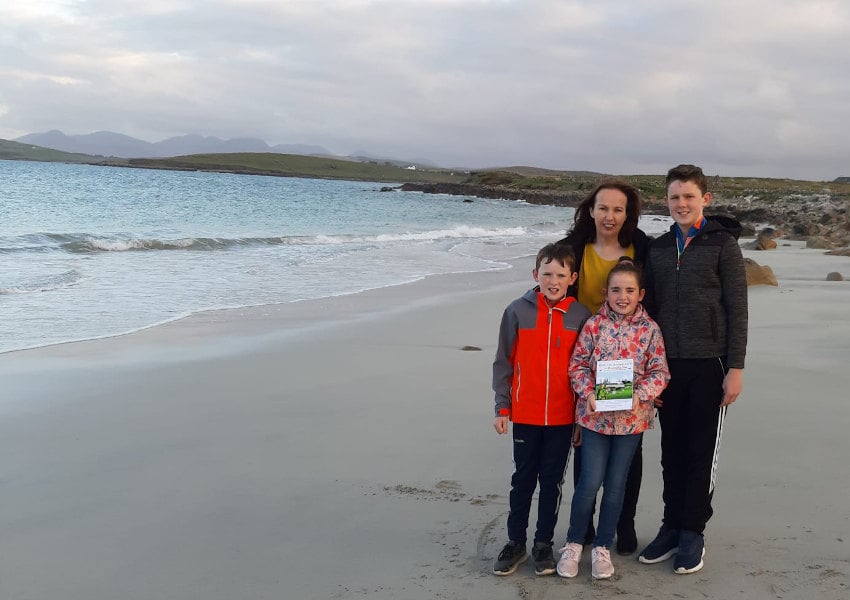 Author Marie Feeney with her children Ronan, Diarmuid and Michaela at Sallerna Beach in Cleggan, Co Galway | Photo: Marie Feeney
Author Marie Feeney with her children Ronan, Diarmuid and Michaela at Sallerna Beach in Cleggan, Co Galway | Photo: Marie Feeney
On the launch of her new book, Marie said: “The coastline of Connemara, while exceptionally beautiful is also treacherous and mostly utilised by people who use it either for pleasure or their livelihood.
“Thankfully in our community, we have a dedicated RNLI volunteer team who provide an invaluable service by saving lives each year, sometimes in the most challenging environments.
“The philosophy of the RNLI is astounding. The purpose to save lives, their vision to save everyone, their volunteer ethos, their charitable and community base. Every life matters, and of course their maritime expertise is crucial.”
From Our Ancient Land to Bountiful Sea is now on sale locally in Connemara at The Clifden Bookshop, Letterfrack Country Shop, Gala Cleggan and Sweeney’s Claddaghduff. The book is also available online at the inConnemara Bookshop.
Reality Meets Myth In Author’s Adventure Along Ireland’s Coast
An encounter with late poet and sailor Danny Sheehy enlivens author Philip Marsden’s adventure along Ireland’s wild Atlantic way, as he writes for The Irish Times.
Marsden had set out to research a book about mythical islands — which took shape as his recently published The Summer Isles — when he was joined by Sheehy in Dingle for a revealing chat that took in everything from the intricacies of boat building to the dangers of the Irish coast that lay ahead.
As it happened, their meeting occurred just weeks before Sheehy lost his life after his naomhóg capsized off Portugal, while Marsden was navigating the Hebrides towards the end point of his own journey.
The Irish Times has much more on the story HERE.
From Enda O’Coineen, in business and adventure, we can learn much. The man sails on a sea of obsession in life — guided only by the goals he sets himself.
He became the first ever Irish entry to qualify for the Vendée Globe. When he didn’t succeed in the solo circumnavigation at his first attempt, due to a broken mast, his default mode was to try again — and he sailed into the history books.
In his daily jousts with the elements at sea, the entrepreneur concludes that for every risk, there is a massive potential for reward and giving back.
But he is alarmed by rules, regulations and controls, hidden in the name of safety and security. Fundamental freedoms are being lost, he says.
The genius is in understanding the balance.
Every four years, an elite group of sailors endeavours to sail single-handed, non-stop in a circumnavigation of the planet, through the most unpredictable and perilous conditions imaginable.
They are the competitors in the Vendée Globe — one of the most arduous, challenging and dangerous events in sport. These sailors know the real adversaries are the waves and the weather, the ice and isolation.
The 2016 race had an Irish skipper competing for the first time, as Irish businessman Enda O’Coineen sailed the Kilcullen Voyager into the annals of sailing history.
But this grand solo voyage did not go to plan.
Also the subject of a documentary that screened as part of the IFI Documentary Festival last month, Enda O’Coineen’s bid to complete the Vendée Globe has been recounted in his own words in a new book.
Journey to the Edge: An Amazing Story of Risk-Taking in Business and Adventure, by Enda O’Coineen, is available from the Afloat shop at €14.99.
‘Round Ireland By Slow Boat’ Recounts A Five-Month Odyssey Around A Country Rarely Seen
Richard and Rita Kennedy’s sailing trip around Ireland was meant to be a 10-week journey. It ended up an odyssey spread over two summers.
But the time was more than well spent, as their leisurely sail became an exploration of an Ireland rarely experienced.
And now the voyage is recounted in a new book which launches in Birr, Co Offaly this Friday (6 September).
Round Ireland by Slow Boat is based on a detailed diary kept by Richard Kennedy as he and his wife set out on their sailing boat Seachrán on what was intended to be a “dream sailing journey” — and eventually became much more than that.
“It is also the story of the landscapes and seascapes we encountered, our adventures and misadventures, and the people we met in the many coastal communities around our shores,” he says.
“It was an unhurried journey, taking five months in total, and in that time we experienced, almost universally, the often unseen kindness of people.”
The charming story also recounts the “formidable challenges mingled with moments of wonder and serendipity” as they followed the island’s meandering coastline, taking in its varied environments and people.
Round Ireland by Slowboat is published by Throughthechair Publishing, priced €15, available from RoundIrelabdBySlowBoat.net
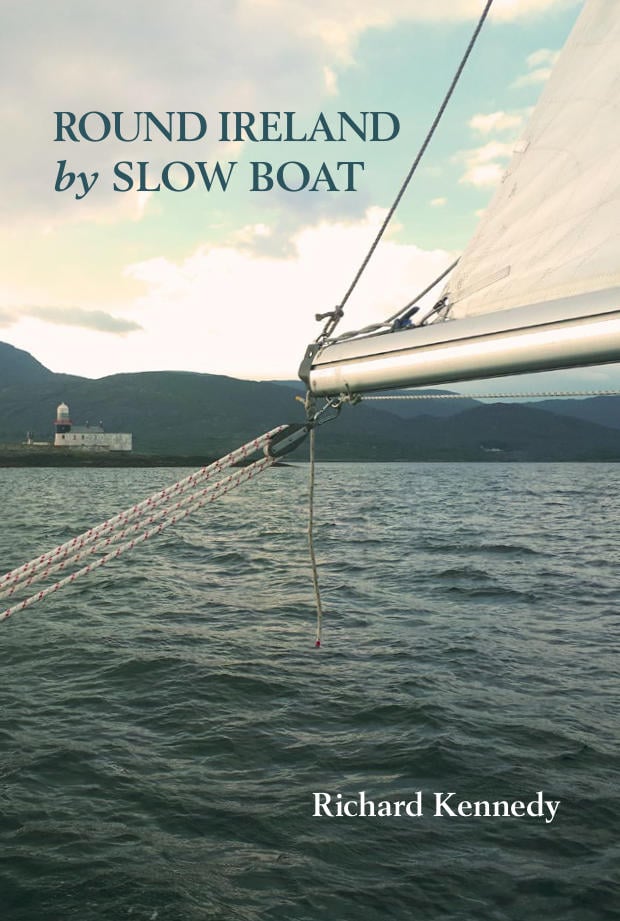
Whales & Dolphins Dominate New Atlas Of Irish Mammals
#MarineWildlife - Ireland’s whales and dolphins feature in a new atlas of the country’s wildlife, as The Irish Times reports.
The Atlas of Mammals in Ireland 2010-2015, published by the National Biodiversity Data Centre, maps the distribution of 77 mammal species both on the island and in its territorial waters.
Cetaceans account for almost a third of this number, among a whopping 68 species of whales and dolphins that frequent Irish waters.
The Irish Whale and Dolphin Group’s Dr Simon Berrow relates his long-term study of the Shannon Estuary’s thriving population of bottlenose dolphins in a book that celebrates an encouraging national habitat for species that struggle not so far from our shores.
Afloat.ie readers might remember a previous atlas concentrating on Ireland’s abundance of marine mammals that was published in 2013, and for which this new book makes a useful comparison.
#OmeyIsland - Omey Island in Connemara is the subject of a new book by a local woman charting its remarkable history.
Strands of Omey's Story by Bernadette Conroy shows there's much more to the lands off Claddaghduff than the annual beach horse race, as Galway Bay FM reports.
Despite not being a true island, as its only cut off from the mainland when the tide is in, Omey has seen its population dwindle from over 100 a century ago to just a single resident in more recent years.
New Book Celebrates 'History Of Irish Water Safety'
#WaterSafety - Irish Water Safety's "long and proud history" has been paid tribute in a new book by author Tiarnan O'Sullivan
The History of Irish Water Safety is the culmination of two years of research by the Cork-based writer, who has been involved with IWS since 2002 both as a pool and beach lifeguard and as an instructor and committee secretary.
The result, published just in time for Christmas, comprises 288 pages of reflections and remembrances from people involved in the organisation right back to its very beginnings in 1945.
Available to order from Irish Water Safety, The Long Walk, Galway or online via [email protected], the book costs €25 for the hardback edition and €15 for the paperback.
New Photographic Book Celebrates The Burren & Cliffs Of Moher
#Burren - The unique landscape of the Burren and the Cliffs of Moher on Ireland's Wild Atlantic Way is the subject of a new book by one of Ireland's leading photographers.
This Is The Burren, Carsten Krieger's photographic ode to the world-famous region, will be launched by Rose Hynes, a native of North Clare and chairperson of Shannon Group plc, in Hyland's Burren Hotel in Lisdoonvarna, Co Clare, this Sunday 29 November.
The Burren and the Cliffs of Moher – which, along with Waterford's Copper Coast, was last week designated with UNESCO Global Geopark status, as the Irish Examiner reports – is among Ireland’s most enigmatic and magical landscapes.
The 176 photographs featured in This Is The Burren – some of which are featured on Krieger's website HERE – capture the essence of the Burren, including its weathered karst landscape, the ever-changing light; the exotic flora; the elusive wildlife; the tombs, cairns, forts and churches; and the people who call the Burren their home.
Carsten Krieger, who was born in Germany, visited the Burren after learning it was the inspiration for JRR Tolkien’s Middle Earth. More visits followed before he and his wife finally decided to move to Co Clare to be close to the unique landscape.
After publishing his first book, Carsten moved on to other projects, but said: "The Burren always stayed close to my heart and in all the books I have made over the past decade the Burren pops up in each of them in one way or another."
Carsten returned to the Burren to take more photographs in 2011, a project that turned into his latest book.
"Although four years sounds like a long time I could easily have spent another couple of years exploring and photographing the Burren, and most likely will do so. Every trip brings something used and unexpected and a reason to return another time," he said.
Cllr James Breen, Cathaoirleach of Clare County Council, described the book as "a valuable photographic record of one of the jewels in the Irish tourism crown."
He added: "Carsten's photographs illustrate perfectly how remarkable the landscape of the Burren really is and why the work of organisations such as the Burren and Cliffs of Moher UNESCO Geopark in heritage management and sustainable development throughout the region is critical.
"The book also is a tribute to how man and nature are deeply entwined in the Burren and have shaped each other over the millennia."
Carol Gleeson, project manager for the Burren and Cliffs of Moher UNESCO Global Geopark, said her and her team were "delighted to have been able to support Carsten and the publication of this book which demonstrates the enormous wealth of history and geological significance associated with the Burren and Cliffs of Moher."
She continued: "Since 2006, Clare County Council has been working in the Burren to develop a truly sustainable tourism destination that gives direct benefits to the local community, promotes and celebrates local culture and produce, preserves the environment and provides a great experience for our visitors.
"Carsten's photographs gives credence to this amazing landscape and the wide range of fantastic work that is ongoing throughout the Burren through sustainable practices."
Carsten Krieger's This Is The Burren, which is introduced by local author and broadcaster PJ Curtis, is published by The Collins Press and is available in all good bookstores and online at www.collinspress.ie.
#RNLI - Christmas came early at Donaghadee Primary School yesterday (Tuesday 24 November) as children enjoyed a reading of an RNLI festive story.
Accompanied by Rookie the RNLI Reindeer and coxswain Philip McNamara, Donaghadee RNLI’s deputy second coxswain John Ashwood read The Big Christmas Rescue to a group of pupils in Primary One.
The kids were able to hear about the station’s all-weather lifeboat and learned about the lifesaving service that the RNLI provides.
The story is set on a wet and windy Christmas Eve night. But when Santa crashes his sleigh in the sea, volunteer RNLI lifeboat crew members go to the rescue.
The Big Christmas Rescue children’s book is also customisable, making it a perfect seasonal gift.
It can be personalised to put young readers at the centre of a magical festive story, and the gift-giver can select the name, gender and skin tone of the child in the story, making it a truly unique present for their own special little person.
"I really enjoyed reading the story to the children," said Ashwood. "They all seemed to enjoy the book and it was great to tell the children about the lifesaving service we provide at the RNLI.
"The Big Christmas Rescue is a really beautiful book and it’s the perfect gift for children this Christmas. I love the way the book can be personalised, putting readers at the heart of the story. Importantly, all profits from sales of the book will help the RNLI continue to save lives at sea."
To order a personalised copy of The Big Christmas Rescue, go to RNLISHOP.org/BigRescue. The last order date for the book to guarantee delivery before Christmas is Sunday 13 December 2015.
All profits from book sales will be used to fund the charity’s lifesaving services, delivered by volunteer lifeboat crews and lifeguards who between them rescued 10,496 people last year – more than 1,400 across the island of Ireland alone.


























